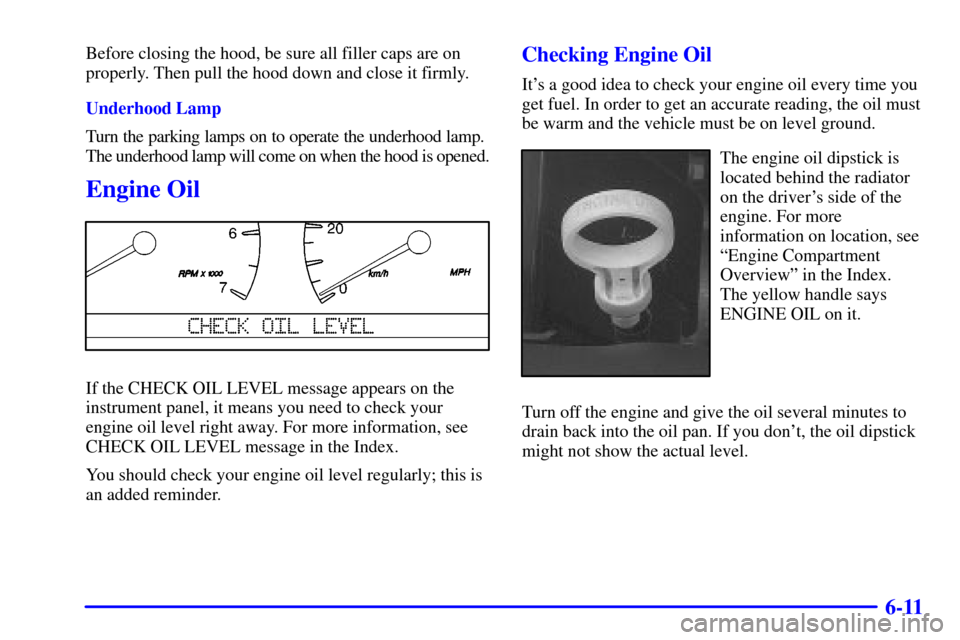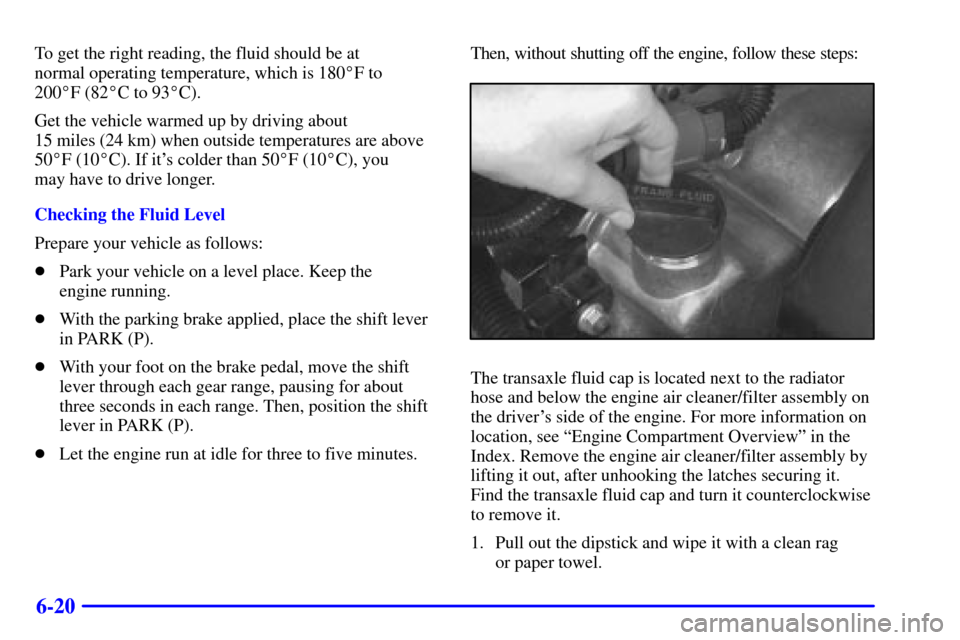Page 239 of 335
5-15
CAUTION: (Continued)
your engine could get too hot but you wouldn't
get the overheat warning. Your engine could
catch fire and you or others could be burned.
Use a 50/50 mixture of clean, drinkable water
and DEX
-COOL� coolant.
NOTICE:
In cold weather, water can freeze and crack the
engine, radiator, heater core and other parts.
So use the recommended coolant.
CAUTION:
You can be burned if you spill coolant on hot
engine parts. Coolant contains ethylene glycol
and it will burn if the engine parts are hot
enough. Don't spill coolant on a hot engine.
1. You can remove the coolant surge tank pressure cap
when the cooling system, including the coolant surge
tank pressure cap and upper radiator hose, is no
longer hot. Turn the pressure cap slowly
counterclockwise (left) until it first stops.
(Don't press down while turning the pressure cap.)
If you hear a hiss, wait for that to stop. A hiss means
there is still some pressure left.
Page 241 of 335
5-17
4. With the coolant surge tank pressure cap off, start the
engine and let it run until you can feel the upper
radiator hose getting hot. Watch out for the engine
cooling fans.
By this time, the coolant level inside the coolant
surge tank may be lower. If the level is lower, add
more of the proper mixture to the coolant surge tank
until the level reaches about 2.5 inches (6.4 cm)
below the base of the filler neck.5. Then replace the pressure cap. Be sure the arrows on
the pressure cap line up like this.
Start the engine and allow it to warm up. If the CHECK
COOLANT LEVEL message does not appear on the
Driver Information Center, coolant is at the proper fill
level. If a CHECK COOLANT LEVEL message does
appear, repeat Steps 1 to 3 and reinstall the pressure cap
or see your dealer.
Page 265 of 335

6-11
Before closing the hood, be sure all filler caps are on
properly. Then pull the hood down and close it firmly.
Underhood Lamp
Turn the parking lamps on to operate the underhood lamp.
The underhood lamp will come on when the hood is opened.
Engine Oil
If the CHECK OIL LEVEL message appears on the
instrument panel, it means you need to check your
engine oil level right away. For more information, see
CHECK OIL LEVEL message in the Index.
You should check your engine oil level regularly; this is
an added reminder.
Checking Engine Oil
It's a good idea to check your engine oil every time you
get fuel. In order to get an accurate reading, the oil must
be warm and the vehicle must be on level ground.
The engine oil dipstick is
located behind the radiator
on the driver's side of the
engine. For more
information on location, see
ªEngine Compartment
Overviewº in the Index.
The yellow handle says
ENGINE OIL on it.
Turn off the engine and give the oil several minutes to
drain back into the oil pan. If you don't, the oil dipstick
might not show the actual level.
Page 266 of 335
6-12
Pull out the dipstick and clean it with a paper towel or
cloth, then push it back in all the way. Remove it again,
keeping the tip down, and check the level.
When to Add Engine Oil
If the oil is at or below the ADD line, then you'll need
to add at least one quart of oil. But you must use the
right kind. This part explains what kind of oil to use. For
crankcase capacity, see ªCapacities and Specificationsº
in the Index.
NOTICE:
Don't add too much oil. If your engine has so
much oil that the oil level gets above the upper
mark that shows the proper operating range,
your engine could be damaged.
The engine oil fill cap is
located behind the radiator
on the passenger's side of
the engine. For more
information on location, see
ªEngine Compartment
Overviewº in the Index.
Turn the cap
counterclockwise to
remove it.
Be sure to fill it enough to put the level somewhere in
the proper operating range. Push the dipstick all the way
back in when you're through.
Page 274 of 335

6-20
To get the right reading, the fluid should be at
normal operating temperature, which is 180�F to
200�F (82�C to 93�C).
Get the vehicle warmed up by driving about
15 miles (24 km) when outside temperatures are above
50�F (10�C). If it's colder than 50�F (10�C), you
may have to drive longer.
Checking the Fluid Level
Prepare your vehicle as follows:
�Park your vehicle on a level place. Keep the
engine running.
�With the parking brake applied, place the shift lever
in PARK (P).
�With your foot on the brake pedal, move the shift
lever through each gear range, pausing for about
three seconds in each range. Then, position the shift
lever in PARK (P).
�Let the engine run at idle for three to five minutes.Then, without shutting off the engine, follow these steps:
The transaxle fluid cap is located next to the radiator
hose and below the engine air cleaner/filter assembly on
the driver's side of the engine. For more information on
location, see ªEngine Compartment Overviewº in the
Index. Remove the engine air cleaner/filter assembly by
lifting it out, after unhooking the latches securing it.
Find the transaxle fluid cap and turn it counterclockwise
to remove it.
1. Pull out the dipstick and wipe it with a clean rag
or paper towel.
Page 279 of 335
6-25
The cooling system is under a lot of pressure when it is
hot. If the CHECK COOLANT LEVEL message
appears on the Driver Information Center (DIC), you
will need to add coolant.
CAUTION:
Turning the surge tank pressure cap when the
engine and radiator are hot can allow steam and
scalding liquids to blow out and burn you badly.
Never turn the surge tank pressure cap
-- even a
little
-- when the engine and radiator are hot.
The vehicle must be on a level surface. When your engine
is cold, the coolant level should be at the full cold mark,
which is 2.5 inches (6.4 cm) below the base of the fill
neck. Use a flashlight as necessary to see into the tank.
If the CHECK COOLANT LEVEL message comes on
and stays on, it means you're low on engine coolant.
For more information, see ªCheck Coolant Level
Messageº in the Index.